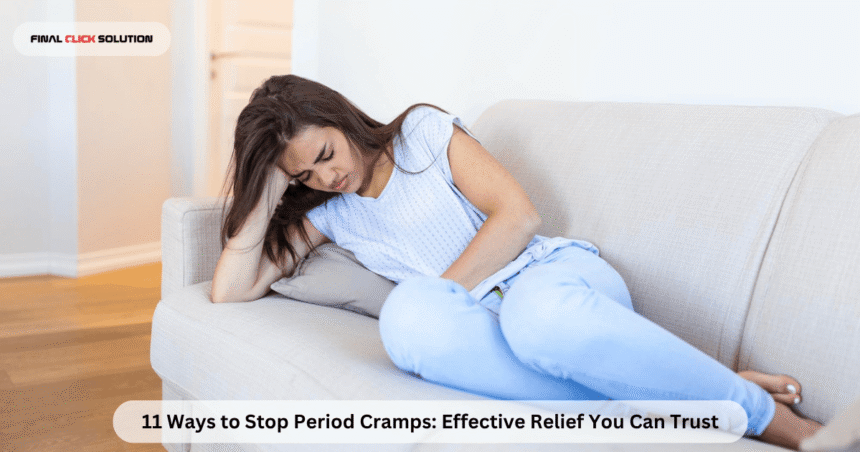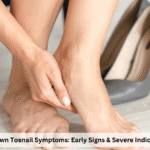Menstrual cramps—medically known as dysmenorrhea—are a monthly struggle for millions of women. These cramps occur when the uterus contracts to shed its lining, often causing discomfort in the lower abdomen, lower back, and even down the legs. While period cramps are common, the pain can range from mildly annoying to completely disabling.
The good news? There are proven, science-backed, natural, and lifestyle-based ways to reduce or even stop period cramps. Whether you experience mild discomfort or intense monthly pain, understanding effective strategies can help you regain control.
This comprehensive guide explores 11 powerful ways to stop period cramps, why they work, when you should try each one, and how to combine them for the best results.
What Causes Period Cramps?
Understanding the cause of cramps makes it easier to manage them.
During menstruation, the uterus produces prostaglandins, hormone-like chemicals that trigger muscle contractions.
High levels of prostaglandins → stronger contractions → decreased blood flow → more pain.
Other factors that can make cramps worse include:
- Stress
- Poor diet
- Lack of exercise
- Underlying health conditions like endometriosis or fibroids
- Smoking
- Hormonal imbalances
Now let’s explore 11 proven ways to stop or significantly reduce period cramps.
1. Apply Heat to Relax the Muscles
Heat therapy is one of the fastest and most effective ways to relieve menstrual pain. Heat increases blood flow, relaxes the uterine muscles, and reduces cramping within minutes.
Ways to Apply Heat
- Heating pad on the lower abdomen
- Warm bath or shower
- Hot water bottle
- Heat patches designed for menstrual relief
Studies show that heat therapy works just as well as over-the-counter pain medications for many women. It’s also safe, natural, and accessible.
2. Take Over-the-Counter Pain Relievers
NSAIDs (Non-Steroidal Anti-Inflammatory Drugs) help reduce prostaglandin levels directly, which tackles the root cause of cramps.
Best Options Include:
- Ibuprofen
- Naproxen
- Aspirin
These medications reduce inflammation, relax muscles, and ease pain. They work best when taken at the first sign of cramps or even the day before your period starts.
However, individuals with certain health conditions—like ulcers, kidney issues, or bleeding disorders—should consult a doctor before taking NSAIDs regularly.
3. Stay Hydrated and Drink Warm Fluids
Dehydration can make cramps worse. When the body lacks water, it retains more sodium, causing bloating and increasing discomfort.
What Helps Most
- Warm water
- Herbal teas (ginger, chamomile, peppermint)
- Coconut water
- Infused water with lemon or cucumber
Warm fluids, in particular, can help relax muscles and improve blood flow, reducing cramping intensity.
4. Gentle Exercise and Movement
It may feel counterintuitive, but movement can significantly ease cramps. Exercise increases endorphins—the body’s natural painkillers—and improves blood circulation.
Best Types of Exercise
- Light walking
- Stretching
- Low-intensity yoga
- Swimming
- Pilates
Certain yoga poses, like child’s pose, cat-cow, and cobra, target the lower abdominal area and provide fast relief.
Regular physical activity throughout the month also helps reduce cramp severity over time.
5. Use Essential Oils for Pain Relief
Aromatherapy and topical essential oils can help relax the muscles and reduce inflammation.
Most Effective Oils
- Lavender oil – reduces pain and promotes relaxation
- Peppermint oil – offers cooling relief and muscle relaxation
- Clary sage oil – helps balance hormones and reduce cramping
Try massaging 2–3 drops mixed with a carrier oil (like coconut or almond oil) onto the lower abdomen.
Studies have shown that essential oil massages can significantly reduce the intensity and duration of menstrual cramps.
6. Improve Your Diet Before and During Your Period
Food plays a major role in hormone balance and inflammation—two major contributors to period pain.
Foods That Reduce Cramps
- Leafy greens (magnesium-rich)
- Bananas (potassium-rich)
- Salmon and chia seeds (omega-3 fatty acids)
- Nuts and seeds
- Yogurt and probiotic-rich foods
- Fresh fruits—especially berries
Foods to Avoid
- Caffeine
- Salty foods
- Alcohol
- Processed snacks
- Sugary foods
These foods worsen inflammation and cause bloating, which intensifies cramps.
Switching to an anti-inflammatory diet throughout the month can dramatically reduce future cycle pain.
7. Try Vitamin and Mineral Supplements
Several supplements have been proven to help reduce menstrual cramps naturally.
Helpful Supplements
- Magnesium – relaxes muscles and reduces cramp severity
- Vitamin B1 (Thiamine) – reduces spasms
- Vitamin E – decreases prostaglandin production
- Omega-3 fatty acids – natural anti-inflammatory
- Calcium – supports muscle function
Always consult your doctor before adding new supplements, especially if you have medical conditions or take other medications.
8. Reduce Stress Through Mind-Body Practices
Stress increases cortisol levels, which can throw off hormones and worsen cramps. Managing stress can significantly reduce pain.
Relaxation Techniques
- Deep breathing exercises
- Meditation
- Guided imagery
- Journaling
- Light stretching
Even 10 minutes of mindfulness daily can help regulate your stress response and reduce menstrual pain.
9. Get Enough Sleep Before and During Your Period
Sleep plays a vital role in hormonal balance and overall pain management. Poor sleep increases inflammatory responses and reduces your pain threshold.
Tips for Better Sleep
- Maintain a consistent bedtime
- Avoid screens before bed
- Use a heating pad to relax
- Keep your room cool and dark
- Avoid heavy meals late at night
Aim for 7–9 hours of restful sleep to support your body’s natural recovery and reduce period discomfort.
10. Consider Hormonal Birth Control for Long-Term Relief
If cramps are severe or interfere with daily life, hormonal birth control may be an option. Birth control regulates hormone levels, thins the uterine lining, and significantly reduces prostaglandins.
Types That Help
- Combination pills
- Hormonal IUD
- Birth control patch
- Birth control ring
For women with conditions like endometriosis, adenomyosis, or PCOS, hormonal therapy can be especially effective.
Consult a healthcare professional to determine which option is best for you.
11. Seek Professional Help for Severe or Persistent Cramps
While period cramps are common, extreme or worsening pain is not normal. If cramps disrupt your daily life, medical evaluation is necessary.
Possible Underlying Conditions
- Endometriosis
- Fibroids
- Pelvic inflammatory disease
- Adenomyosis
- Ovarian cysts
Talk to a doctor if you experience:
- Pain that worsens each month
- Pain unresponsive to medication or home remedies
- Heavy bleeding with clots
- Cramps lasting longer than your period
- Pain between periods
Early diagnosis can prevent long-term complications and improve your quality of life.
Conclusion: You Don’t Have to Suffer Through Period Cramps
Period cramps may be common, but they don’t have to control your life. From heat therapy and hydration to exercise, dietary changes, and hormonal treatment, there are many effective ways to stop or significantly reduce menstrual pain.
The key is to try different strategies and discover what works best for your body. Remember: persistent or severe pain is not normal and should be evaluated by a healthcare professional.
With the right combination of natural remedies, healthy lifestyle choices, and medical support when needed, you can experience easier, more comfortable periods.






